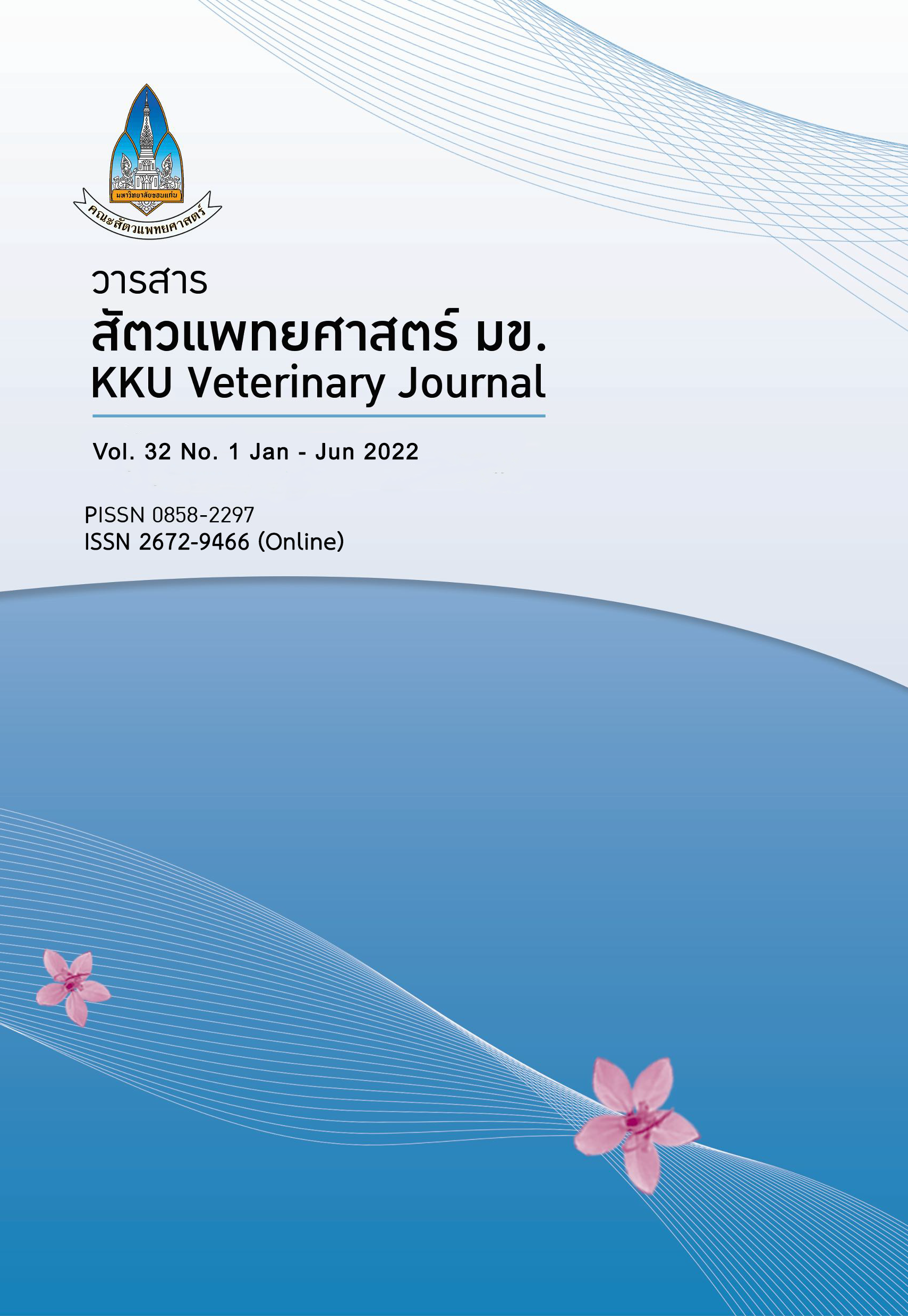ผลของหอมแดงสดในอาหารต่อสมรรถนะการผลิตและลักษณะซากของเป็ดเนื้อ
Main Article Content
บทคัดย่อ
บทนำ หอมแดงมีสารประกอบโพลีฟีนอลที่ออกฤทธิ์ต้านจุลชีพและต้านอนุมูลอิสระ และมีสารอัลลิซินซึ่งมีฤทธิ์กระตุ้นการหลั่งเอนไซม์ กระตุ้นการบีบและหดตัวของลำไส้ ทำให้การย่อยอาหารเป็นไปอย่างมีประสิทธิภาพ และช่วยดูดซึมอาหารที่ลำไส้ได้
วัตถุประสงค์ การศึกษานี้จึงมีวัตถุประสงค์เพื่อศึกษาผลของหอมแดงสดในอาหารต่อสมรรถนะการผลิตและลักษณะซากของเป็ดเนื้อ
วัสดุ อุปกรณ์ และวิธีการ วางแผนการทดลองแบบสุ่มสมบูรณ์ ใช้เป็ดเนื้อคละเพศอายุ 3 สัปดาห์ จำนวน 96 ตัว แบ่งออกเป็น 3 กลุ่มการทดลองๆ ละ 4 ซ้ำๆ ละ 8 ตัว เป็ดแต่ละกลุ่มการทดลองได้รับอาหารดังนี้ กลุ่มที่ 1 อาหารควบคุม (0% หอมแดงสด) กลุ่มที่ 2 และ 3 ได้รับอาหารทดลองที่มีหอมแดงสดที่ระดับ 2.5 และ 5% ตามลำดับ เมื่อสิ้นสุดการเลี้ยง เป็ดเนื้ออายุ 12 สัปดาห์ สุ่มเป็ดในแต่ละซ้ำๆ ละ 2 ตัว (เพศผู้ 1 ตัว และเพศเมีย 1 ตัว) เพื่อศึกษาลักษณะซาก
ผลการศึกษา พบว่าการใช้หอมแดงสดที่ระดับ 2.5% ในเป็ดเนื้อช่วงอายุ 3-6 สัปดาห์ มีผลให้อัตราการเจริญเติบโต และการกินอาหารสูงกว่ากลุ่มการทดลองอื่นๆ (P<0.05) อย่างไรก็ตามไม่พบความแตกต่างของสมรรถนะการผลิตและลักษณะซากระหว่างกลุ่มการทดลองในเป็ดเนื้อที่อายุมากกว่า 6 สัปดาห์ ขึ้นไป (6-12 สัปดาห์)
สรุป การศึกษาครั้งนี้สรุปได้ว่า หอมแดงสดสามารถใช้ในสูตรอาหารเป็ดเนื้อได้ถึงระดับ 2.5% โดยไม่มีผลเชิงลบต่อสรรถนะการผลิตและลักษณะซากของเป็ดเนื้อ
Article Details

อนุญาตภายใต้เงื่อนไข Creative Commons Attribution-NonCommercial-NoDerivatives 4.0 International License.
เอกสารอ้างอิง
Adeniyi BA, Anyiam FM. 2004. In vitro anti-Helicobacter pylori potential of methanol extract of Allium ascalonicum Linn. (Liliaceae) leaf: susceptibility and effect on urease activity. Phytother Res 18, 358-361.
Assatarakul K, Himasuttidach N. 2017. Antioxidant and antibacterial activities of onionextract and applications in mixed fruit and vegetable juice. J Food Tech, Siam University 12, 71-83.
Buaban R, Tathong T, Klongdee K. 2013. Carcass quality, carcass composition and meat quality of Muscovy in small farming. Khon Kaen Agr J 41 Supplement 1, 388-393.
Bureau of nutrition. 2018. Food composition table of Thai foods. Department of Health, Ministry of Public Health. El-Samee LDA, El-Allawy HMH, Maghraby NA. 2012. Comparative study on some productive traits of Muscovy and Sudani ducks in Egypt. Int J Poult Sci 11, 264-268.
Fadlalla IMT, Mohammed BH, Bakhiet AO. 2010. Effect of feeding garlic on the performance and immunity of broilers. Asian J Poult Sci 4, 182-189.
Goliomytis M, Panopoulou E, Rogdakis E. 2003. Growth curves for body weight and major component parts, feed consumption, and mortality of male broiler chickens raised to maturity. Poult Sci 82, 1061-1068.
Luangnateethep R. 1997. Spice plant and herbs. OS printing house. Bangkok. Mnayer D, F-Tixier A-S, Petitcolas E, Hamieh T, Nehme N, Ferrant C, Fernandez X, Chemat F.2014. Chemical composition, antibacterial and antioxidant activities of six essentials oils from the Alliaceae Family. Molecules 19, 20034-20053.
Muangkote S, Vichitsoonthonkul T, Srilaong V, Wongs-Aree C, Photchanachai S. 2014. Inhibition of human bacterial pathogens from roasted garlic, shallot and dried chili crude extracts. Agricultural Sci J 45(2) (Suppl.), 297-300.
National Research Council (NRC). 1994. Nutrient Requirements of Poultry. 9th Rev. Ed. National Academy Press. Washington, D.C.
Paraksa N. 2012. Potential and direction of herbal in livestock. Khon Kaen Agr J, 40(2) (Supple.), 110-113.
Paraksa N, songserm T, Paraksa S. 2005. Research handbook 3 “Determination of pharmaceuticals property of herbal in poultry and swine”. Text and journal publication. Bangkok.
Ruangrungsri N. 1999. Kruangthet. Chulalongkon University Publisher. Bangkok. SAS. 1996. User’s guide: Statistics. USA: SAS Institute Inc., Cary, NC.
Srangyanang P. 2004. Effects of banana (Musa sapientum Linn.) powder as herbal feed additive on growth performance and disease control in broiler diets. Proceedings of the 2nd Thai herbal, Opportunity and new alternatives of animal production industry; Jan 15-16, 2004. Bangkok, Thailand. 8-15.
Steczny K, Ku´zniacka J, Adamski M. 2015. Comparison of growth rate and body weight of ducks of different origins. Acta Sci Pol Zootechnica 14, 97-106.
Werawattanachai N, Kaewamatawong R, Junlatat J, Sripanidkulchai B. 2015. Anti-inflammatory potential of ethanolic bulb extract of Allium ascalonicum. J Sci Technol, Ubon Ratchathani University 17, 63-68.
Wiyabot T. 2012. Effects of crude extract Tinospora crispa supplementation in ducks diets on growth performance and carcass quality. Khon Kaen Agr J. 40 Supplement2, 484-487.
Zeng QF, Yang GL, Liu GN, Wang JP, Bai SP, Ding XM, Luo YH, Zhang KY. 2014.
Effects of dietary gossypol concentration on growth performance, blood profiles, and hepatic histopathology in meat ducks. Poult Sci 93, 2000-2009.
Zeng QF, Cherry P, Doster A, Murdoch R, Adeola O, Applegate TJ. 2015. Effect of dietary
energy and protein content on growth and carcass traits of Pekin ducks.
Poult Sci 94, 384-394.


